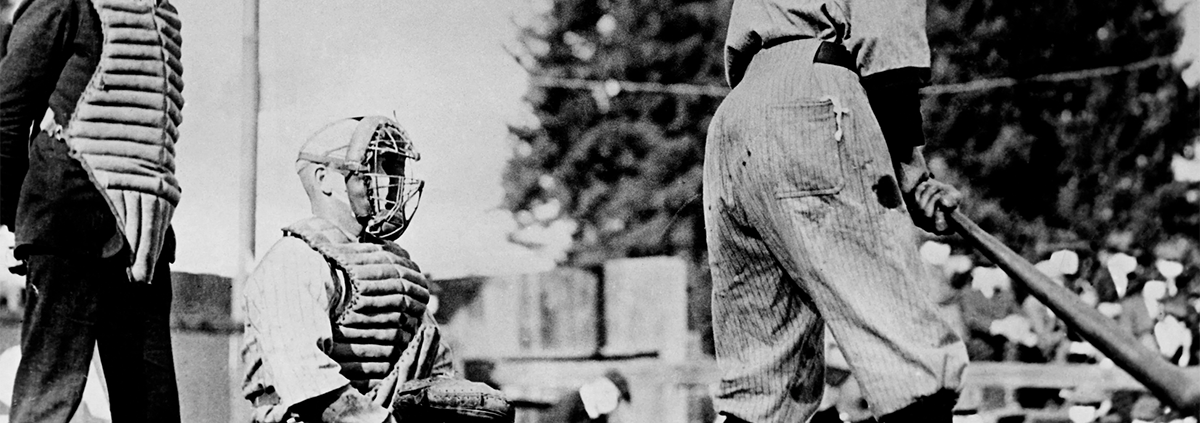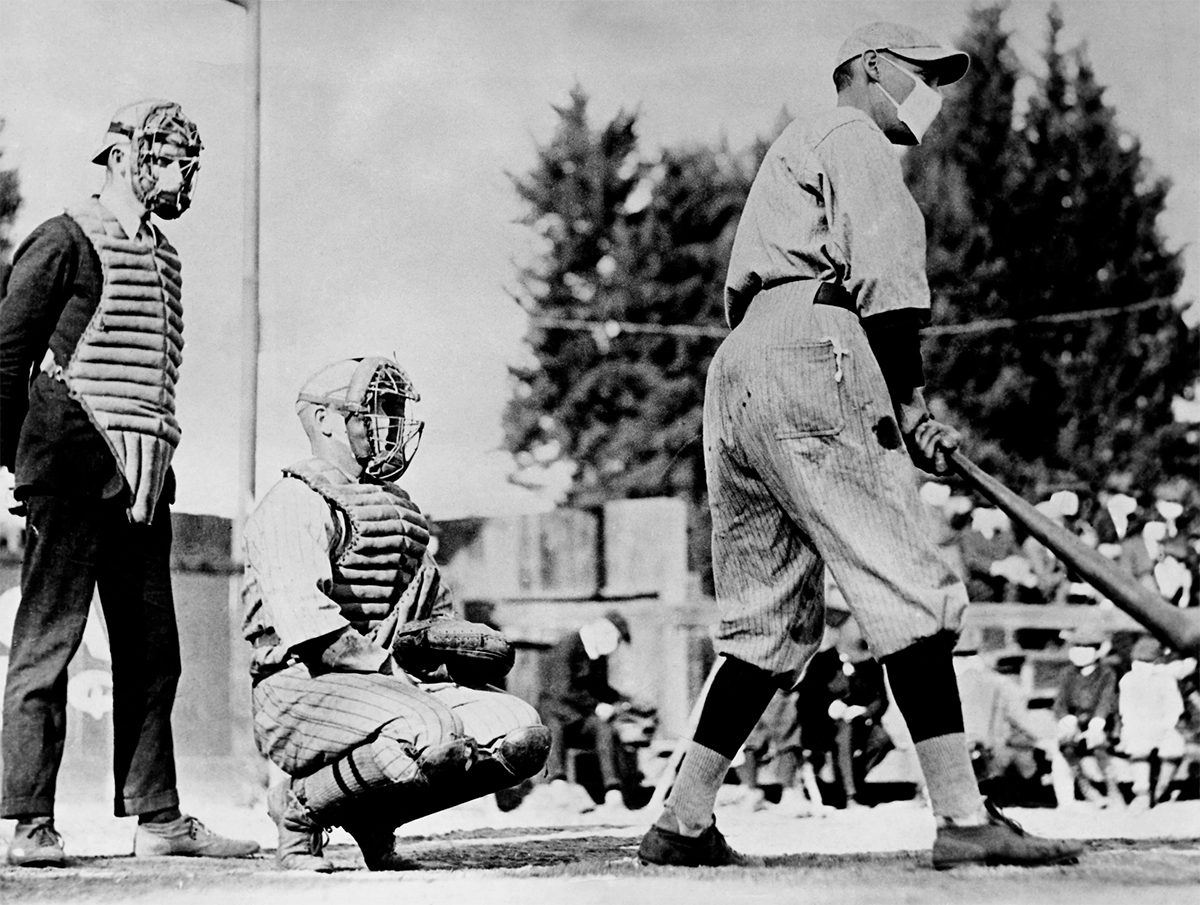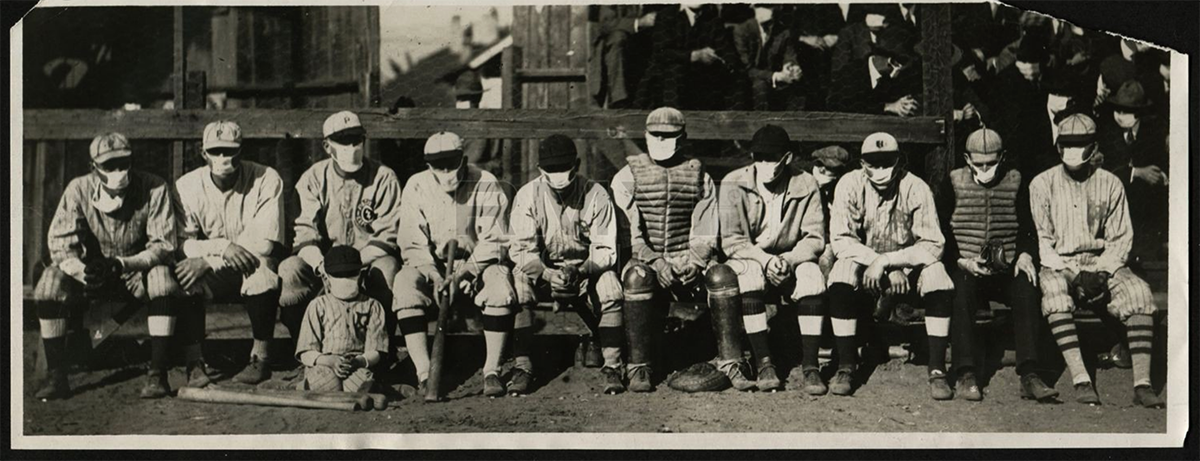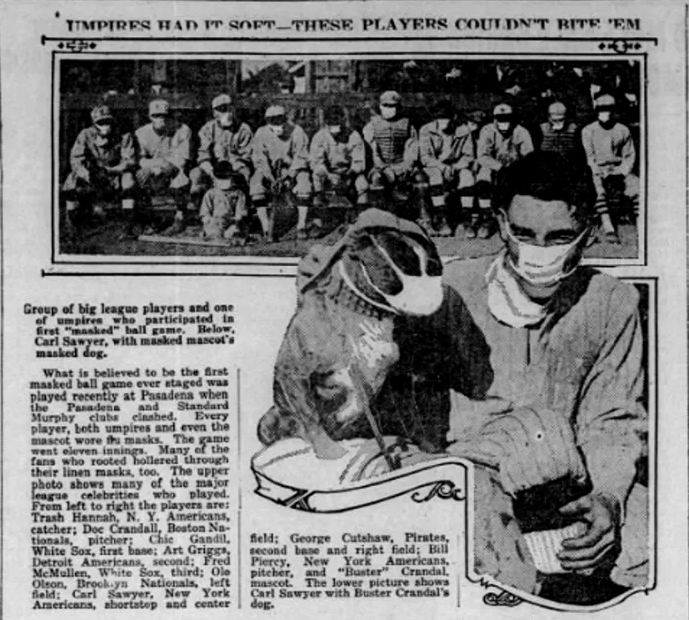January 26, 1919: The Flu Mask Baseball Game
John “Beans” Reardon, left, wearing a flu mask underneath his umpire’s mask, prepares to call a pitch in a California Winter League game on January 26, 1919, in Pasadena, California. During a global influenza pandemic, all players and fans were required by city ordinance to wear facial coverings at all times while outdoors. The catcher and batter’s identities are unconfirmed, but the best available evidence suggests it might be Truck Hannah behind the plate and Rube Ellis at bat. (Author’s collection)
A batter, catcher, and umpire stand at home plate, all wearing cloth masks over their mouth and nose. The fans in the wooden bleachers are wearing masks, too. Even the canine mascot has its snout covered.
The photographs are some of the most enduring images of a global influenza pandemic that infected an estimated 500 million people, nearly one-third of the world’s population, and the cause of nearly 50 million deaths over a 24-month span.1 They are a sign of the human desire to carry on in the face of horrific tragedy and of baseball’s place in American culture.
If these images did not survive, it might be hard to believe such an absurd spectacle ever took place: a baseball game played while everyone present was wearing flu masks. It happened only once, during a California Winter League game on January 26, 1919, in Pasadena, where city officials enacted — and enforced — a strict ordinance requiring all citizens to cover their faces while out in public.2
By the end of the week, the mask order was lifted and life slowly returned to normal. But for one Sunday afternoon, baseball could not provide any escape from the real world and a public-health crisis that hit far too close to home.
Baseball in 1918 was affected more by World War I than by the growing influenza pandemic. The major-league regular season was cut short by the US government’s “work or fight” order, requiring all able-bodied men to enlist in the military or take an essential defense-industry job. The World Series between the Boston Red Sox and Chicago Cubs was played in early September. After the season, many players traveled west to California to enjoy the balmy climate and continue playing all winter against top major-league, minor-league, and Negro League stars.3
The opening of the California Winter League season on Sunday, October 6, went smoothly, with a powerhouse team sponsored by the Merchants National Bank in Pasadena squaring off against its top rival, a team based at the Standard-Murphy Oil Company plant in La Habra. Pasadena won 5-4 in the first of nine games they would play each other all winter.
Pasadena’s roster included Emil “Irish” Meusel of the Philadelphia Phillies, Fred McMullin and Frank Shellenback of the Chicago White Sox, George Cutshaw of the Pittsburgh Pirates, and Pete Schneider and Red Killefer of the Cincinnati Reds.
The Standard Oil lineup had a battery of former New York Giants pitcher Doc Crandall and Yankees catcher Truck Hannah, plus Chick Gandil of the White Sox, Art Griggs of the Detroit Tigers, and Johnny Rawlings of the Boston Braves.
Unfortunately, the flu pandemic that began in the spring of 1918 returned with a vengeance in the fall. The flu’s second wave devastated Southern California before the two baseball teams could return to the field for their next game. On October 11 the City of Los Angeles declared a public-health emergency, taking quick and decisive action to close down schools, theaters, and public gatherings of any kind.4 When the Great War finally ended in November, massive celebrations were held all across the country and the flu reached its peak. But over the following weeks, the infection rate began to subside, and Los Angeles lifted its ban on public gatherings in early December.
As winter-league baseball resumed play after a six-week hiatus, the flu continued to send shock waves throughout the game. Pasadena outfielder Carl Sawyer’s wife, Nell, died of the virus after giving birth to their daughter in October; the child passed away the next day.5 Pitchers Frank Shellenback and Walt Slagle and outfielder George Cutshaw all reportedly contracted the flu in December and were forced to miss a few games while they recovered at home.6 Two more Pasadena-Standard Oil games had to be postponed that month because of health concerns. Major-league umpire Silk O’Loughlin was among the more than 675,000 Americans who died during the pandemic.7
On New Year’s Day 1919, the Rose Bowl was played in Pasadena between military service teams instead of college athletes. George Halas, who would make his major-league baseball debut with the New York Yankees a few months later before going on to a legendary NFL coaching career with the Chicago Bears, was named the game’s MVP after leading the Illinois-based Great Lakes Naval Station team to a 17-0 win in front of 25,000 fans at Tournament Park.8
The Rose Bowl crowd was small by football standards, but that many people gathering together in one place likely helped contribute to a deadly third wave of the flu striking early in the new year. By mid-January, public-health officials were calling for another shutdown to help combat the virus. Fans at some sporting events were required to wear flu masks, including at a University of Missouri men’s basketball game and a boxing match in San Francisco.9
On January 18 the City of Pasadena issued a strict order requiring that flu masks be worn at all times in public; even dogs were not exempt. Fifty people were arrested and fined for not wearing masks on the first business day after the ordinance took effect.10 Not everyone was happy about the new law, but city officials were serious about enforcing it.
The Pasadena-Standard Oil winter-league game scheduled for January 19 was postponed after “players on both teams rebelled … when they learned they were supposed to wear flu masks while engaged in the national pastime,” the Los Angeles Evening Express reported.11 But soon an idea emerged to Merchants manager Loren Ury: Why not try playing a game while still following the law? “By playing the game with the men wearing masks, the managers of the clubs would have drawn a big crowd,” wrote Matt Gallagher of the Los Angeles Evening Herald.12 No one seemed to ask Dr. Luther Powers, the city’s health commissioner, what he thought of that bright idea.
Ury invited photographers and “moving picture” cameramen to attend the baseball game, set for the next Sunday, January 26, at Carmelita Park, located just north of the Rose Bowl parade route near Colorado and Orange Grove Boulevards.13 No attendance total was recorded, but photos show a sprinkling of fans in small wooden bleachers set up down the third-base and presumably first-base lines. Even Doc Crandall’s dog was sporting a gauze mask covering its face.
The Pasadena Merchants winter league team poses for a photo with umpire John “Beans” Reardon, second from right, during the “flu mask” baseball game on January 26, 1919. Among the players on Pasadena’s roster were Emil “Irish” Meusel of the Philadelphia Phillies, Fred McMullin and Frank Shellenback of the Chicago White Sox, George Cutshaw of the Pittsburgh Pirates, and Pete Schneider and Red Killefer of the Cincinnati Reds. The players’ exact order in this photo is unknown. (RMY Auctions)
Behind the plate — wearing a flu mask under his umpire’s mask — was 21-year-old John “Beans” Reardon, the most respected amateur arbiter in the city. He began his professional career just a few months later and would go on to call five World Series and three All-Star Games as a National League umpire for 24 seasons.14
Carl Sawyer provided some comic relief during the game when he came to the plate using his “trick bat … aided and abetted by firecrackers, skyrockets, and sulphur smoke, which was one of the best side shows seen on a local diamond.”15 Truck Hannah, the Standard Oil catcher, “attempted to substitute his catcher’s mask for his ‘flu’ mask, but the health officer spotted him.”16 If anyone else minded wearing a mask, their concerns were quickly dispelled by the excitement of a spirited battle between two strong, competitive teams. As the Los Angeles Herald reported, “The rooting of the fans and their ‘kill the umpire’ cry was somewhat muffled by the gauze masks, but otherwise they appeared to enjoy the contest.”17
The masks seemed to affect the pitchers more than the batters, as the teams combined for 30 hits and 19 runs. Pasadena’s John Sullivan and Doc Crandall, Standard Oil’s starting pitcher, each connected for two home runs. Hannah and Johnny Rawlings also went deep for Standard, while Irish Meusel “peered over the edge of his mask” to smash four hits for Pasadena.18
Pasadena tied the game 9-9 with two runs in the bottom of the ninth inning, but Standard rallied to win in the 11th. Karl Crandall — who during the PCL season had broken up his brother Doc’s no-hit bid for the Los Angeles Angels19 — walked with two outs and then advanced to second, then third base on wild pitches by Sullivan. Chick Gandil then “punched out a Texas Leaguer” to score Crandall with the go-ahead run.
Doc Crandall, who pitched all 11 innings for Standard, worked around two singles to retire the side in the bottom half. Sullivan came to the plate seeking his third home run of the day and “the crowd called for him to do something,” but he hit a sharp grounder to shortstop Ole Olsen, who handled the play “in a business-like manner” for the final out.20
The flu mask game did not immediately cause much of a stir. When Pasadena lifted its mask ordinance for good four days later, the city rejoiced with an impromptu parade of cars tooting their horns along the main thoroughfares. A police officer burned his mask in the middle of the street, causing other citizens to join in and start a small bonfire on Colorado Boulevard.21 The winter-league baseball schedule resumed the following weekend — without masks — until the players had to report for spring training in March.
A few weeks later, the photographs taken at the game began circulating, imprinting this unusual confluence of baseball and a pandemic in the nation’s consciousness forever. Norman E. Brown of the Cleveland-based Central Press Association wire service created a series of illustrations with star major-league players wearing flu masks. Newspapers around the country asked fans to guess the identity of each masked player and revealed the answer the next day.22
Among the players depicted were Shoeless Joe Jackson of the White Sox and Edd Roush of the Reds, who would meet up in a fateful World Series that October along with Chick Gandil and Fred McMullin, two participants from the California flu-mask game. By then, the pandemic was largely over and baseball had a new crisis to deal with, a scourge of corruption that threatened the game’s integrity more than its immune system: the Black Sox Scandal.
At right, Carl Sawyer poses with Doc Crandall’s dog, both sporting face coverings on January 26, 1919, in Pasadena, California. The influenza pandemic infected an estimated 500 million around the world. (Author’s collection)
Sources and acknowledgments
Thanks to Tom Shieber at the National Baseball Hall of Fame Library for his help in finding additional photos and confirming the players who were involved in this game. Shieber identified the photographer as Frank S. Wilton, a well-known newspaper and film studio cameraman from Huntington Park, California. Thanks also to Eileen King and Christine Rice at the Los Angeles Public Library and Yuriy Shcherbina and Suzanne Noruschat at the University of Southern California for their assistance in tracking down sources.
The most detailed recaps of this game were found in:
“Pasadena Ball Game Masked,” Los Angeles Evening Herald, January 27, 1919; and
“Standard Takes Series from Pasadena,” Whittier News, January 28, 1919 (reprinted from the Pasadena Star-News).
These accounts were invaluable in piecing together the story of this game, along with:
Baccellieri, Emma. “Masks, Fundraisers and Smallpox-Only Teams: How Baseball Has Dealt With Infectious Diseases Before,” Sports Illustrated, March 9, 2020, si.com/mlb/2020/03/09/coronavirus-baseball-history.
McNeil, William F. The California Winter League: America’s First Integrated Professional Baseball League (Jefferson, North Carolina: McFarland & Co., 2002).
Navarro, J. Alex, and Howard Markel, eds., Influenza Encyclopedia, University of Michigan Center for the History of Medicine, influenzaarchive.org.
Notes
1 “1918 Pandemic (H1N1 Virus),” Centers for Disease Control and Protection, cdc.gov/flu/pandemic-resources/1918-pandemic-h1n1.html, accessed May 7, 2020.
2 “Los Angeles, California,” Influenza Encyclopedia, eds. J. Alex Navarro and Howard Markel, University of Michigan Center for the History of Medicine, https://influenzaarchive.org/cities/city-losangeles.html, accessed May 7, 2020.
3 William F. McNeil, The California Winter League: America’s First Integrated Professional Baseball League (Jefferson, North Carolina: McFarland & Co., 2002), 13-15. For most of the California Winter League’s history, it was an integrated league. In 1910 Rube Foster and the Chicago Leland Giants began traveling west to test their skills against white stars from the major and minor leagues. For the next three decades, until World War II forced the league to shut down in the 1940s, Negro League players such as Satchel Paige, Oscar Charleston, Biz Mackey, and Turkey Stearnes played for all-black teams like the Los Angeles White Sox nearly every winter. The 1918-19 season was rare in that no black players were allowed to participate. In 1914, Pacific Coast League President Allen T. Baum “insisted that the color line be drawn” and banned blacks from playing in any of the league’s parks. The ban discouraged Foster and other all-black teams from traveling west during the winter. In 1920, the popular L.A. White Sox built their own ballpark and the league once again thrived with at least one all-black team every year until 1945.
4 James Rainey and Rong-Gong Lin II, “California Lessons from the 1918 Pandemic: San Francisco Dithered; Los Angeles Acted and Saved Lives,” Los Angeles Times, April 19, 2020, latimes.com/california/story/2020-04-19/coronavirus-lessons-from-great-1918-spanish-flu-pandemic, accessed May 10, 2020.
5 Stephen V. Rice, “Carl Sawyer,” SABR BioProject, sabr.org/bioproj/person/bf817fe2, accessed May 10, 2020.
6 “Shellenbach, Slagle Ill with Influenza,” Los Angeles Herald, December 17, 1918; “Pasadena, Standards to Meet in 3d of Series,” Los Angeles Herald, January 18, 1919.
7 Bill Francis, “1918 Flu Pandemic Did Not Spare Baseball,” National Baseball Hall of Fame and Museum, baseballhall.org/discover/1918-flu-pandemic-didnt-spare-baseball, accessed May 10, 2020.
8 The Rose Bowl played January 1, 1919, capped the 1918 college football season and is statistically recorded as the 1918 Rose Bowl. sports-reference.com/cfb/bowls/rose-bowl.html.
9 “ Flu’ Masks in Vogue While Tigers Defeat Ames’ Basket Team,” St. Louis Star, January 11, 1919; “Influenza Masks Didn’t Bother Fight Fans,” Oakland Tribune, January 26, 1919.
10 “Pasadena ‘Flu’ Mask Law Wide in Scope; Dogs, Cats Don ’Em,” Los Angeles Evening Express, January 20, 1919.
11 “Pasadena Ball Game Postponed One Week,” Los Angeles Evening Express, January 19, 1919.
12 Matt Gallagher, “Baseball Gossip,” Los Angeles Evening Herald, January 20, 1919.
13 The ballpark was located near the current site of the Norton Simon Art Museum next to Carmelita Gardens.
14“Beans Reardon,” Retrosheet.org, retrosheet.org/boxesetc/R/Prearb901.htm, accessed May 21, 2020.
15 “Standard Takes Series from Pasadena,” Whittier News, January 28, 1919.
16 “Players, Umps, and Fans Wear Masks During Flu Scare,” Washington Herald, February 10, 1919: 8.
17 “Pasadena Ball Game Masked,” Los Angeles Evening Herald, January 27, 1919.
18 Washington Herald, February 10, 1919.
19 R.J. Lesch, “Doc Crandall,” SABR BioProject, sabr.org/bioproj/person/93ccb646, accessed May 10, 2020.
20 Whittier News, January 28, 1919.
21 “Pasadena Repeals Mask Ordinance,” Santa Barbara Daily News, January 31, 1919.
22 The Charlotte News and Fort Worth Record were among many newspapers to print the “masked” photo illustrations in March 1919. The illustration of Shoeless Joe Jackson can be found at newspapers.com/clip/51830833/palladium-item, from the Richmond (Indiana) Palladium-Item on March 31, 1919.
Additional Stats
Standard-Murphy Oil Co. 10
Pasadena Merchants 9
11 innings
Carmelita Park
Pasadena, CA
Corrections? Additions?
If you can help us improve this game story, contact us.





